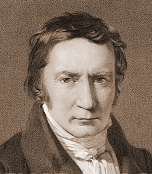Finnur Magnússon

Finnur Magnússon, sometimes referred to by the
Biography
Finnur Magnússon was born in
Finnur studied law at the University of Copenhagen and returned to Iceland to work in Reykjavík, where he became a clerk in the superior court in 1806.[6][7][8] In 1812[6] he returned to Denmark to study Old Norse literature and history and in 1815 became a professor of literature at Copenhagen. In 1819, he was assigned to hold lectures in Norse literature and mythology at the university and the Academy of Art.[7] In 1823 he obtained a position at the King's private archive, and in 1829 became its head.[6] In 1836 he earned his doctorate.[9] He represented Iceland and the Faroes on the Østifternes Stænderforsamling[10] and in 1839 was appointed to represent it on the Danish provincial advisory council (Rådgivende provinsialstænderforsamlinger).[6]
He was a founder member of the
He was interested in and called on for his expertise in
He saw no conflict between Danish and Icelandic nationalism, and regarded Danish as his second native language; while still a student he published a book of poems in Danish (Ubetydeligheder - Inconsequentialities, 1800),[20] and he also wrote Icelandic poetry.[6]
He was married in 1821 to Nicoline Frydensberg (1804–1886), born in Reykjavík, but the marriage was dissolved in 1840.
Selected works
- Udsigt over de kaukasiske Menneskestammers ældste Hjemsted og Udvandringer (1818)[7]
- Bidrag til nordisk Archæologie (1820), in which he maintained the Norse myths to be as appropriate as those of the Greeks for artistic representation[22]
- Den Ældre Edda: En samling af de nordiske folks ældste sagn og sange (1821–23)[7]
- Magnuson, F. (1822). De Annulo aureo Runicis Characteribus signato, nuper in Anglia invento, et pluribus ejusdem Generis, brevis Dissertatio. Archaeologia Aeliana Series 1. Vol 1, p. 136.[1]
- Eddalæren og dens oprindelse (1824–26)[7]
- Priscae veterum borealium mythologiae lexicon (1828)
- Catalogus Criticus Et Historico-Literarius Codicum ClIII Manuscriptorum Borealium (1832)
- Grønlands historiske Mindesmærker (3 vols., 1838–42, with Carl Christian Rafn)[7]
- Runamo og Runerne (1841)
- Antiquités russes (2 vols., 1850–52, with Carl Christian Rafn)
Sources
- N.M. Petersen, "Finn Magnusen's literære Personlighed" in Samlede Afhandlinger volume 3 (Copenhagen: Wibes, 1873) (in Danish)
- Aðalgeir Kristjánsson, Nú heilsar þér á Hafnarslóð, pp. 35–59 (in Icelandic)
- Jón Helgason, "Finnur Magnússon" in Ritgerðakorn og ræðustúfar (Reykjavík: Félag íslenzkra stúdenta í Kaupmannahöfn, 1959), pp. 171–96 (in Icelandic)
- Helga Skúladottir and Sigfús A. Schopka, "Landkönnuðurinn og Leyndarskjalavörðurinn", Morgunblaðið 20 July 1996 (in Icelandic)
- Ulrich Schnell, Runerne på Runamo (in Danish)
- Ripley, George; Dana, Charles A., eds. (1879). . The American Cyclopædia.
References
- ^ a b "Library". archaeologydataservice.ac.uk. Retrieved 3 December 2022.
- ^ Halldór Hermannsson, The Periodical Literature of Iceland Down to the Year 1874, Islandica XI (1918), p. 28.
- ^ a b Jón Helgason, "Magnússon, Finnur", Dansk Biografisk Leksikon November 1938, volume 15, p. 234. (in Danish) (pdf)
- ^ Paul Henri Mallet, tr. Thomas Percy, Northern Antiquities: or, An Historical Account of the Manners, Customs, Religion and Laws, Maritime Expeditions and Discoveries, Language and Literature of the Ancient Scandinavians, London: Bohn, 1847, OCLC 15684911, p. 265, note.
- ^ North Ludlow Beamish, The Discovery of America by the Northmen, in the Tenth Century, London: Boone, 1841, OCLC 493427872, p. 247, Table VII: Descendants of Ari Marson: Brought down to the Present Time.
- ^ a b c d e f g Finnur Magnusson: Biografi at kalliope.org. (in Danish)
- ^ a b c d e f "Magnusson, Finnur", Norsk Haandlexikon, ed. Chr. Johnsen, 1881-88, pp. 397–398. (in Norwegian)
- ISBN 1-84384-063-4, pp. 30–50, p. 35, he failed to graduate.
- ^ Jón Helgason, p. 238.
- ^ a b c Jón Helgason, p. 237.
- ^ Halldór Hermannsson, pp. 28, 34.
- ^ 4 volumes, Copenhagen: Gyldendal, 1824-1826, OCLC 602105850.
- ISBN 0-85991-644-8, p. 189: "the myths reflected primitive responses, sensuous and intense, to the natural forces governing individuals' lives since the dawn of civilisation".
- ^ Jón Helgason, p. 236.
- ^ American Antiquarian Society Members Directory
- ISBN 0-85991-608-1, p. 46.
- ^ An 1891 book review in The Nation ("The Icelandic Discovery of America", 15 January 1891, volume 52, p. 55) refers to his "serious errors" in this matter, calls the inscription "unmistakably Indian graffiti", and summarises Gustav Storm's critique.
- ^ Jón Helgason, pp. 236-37.
- ^ Magnús Fjaldall reproduces his reading, points out that it was based on a bad lithograph, and states that it "came complete with a detailed description of a hitherto unknown language and a mysterious civilisation" (p. 41).
- ^ Jón Helgason, p. 235.
- ISBN 87-635-0554-1, pp. 173-90, pp. 174-78.
- The American Cyclopædia.
